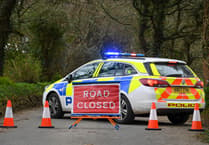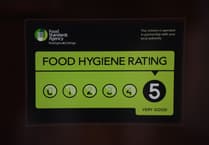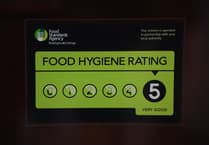Everyone knows that Looe has a fishing fleet, most people realise it also has it own market where the daily catch is sold.
But probably few realise how it actually works, even the non fishing residents of the port are probably not aware of the magnitude of the industry within their midst, which including the fishermen has a workforce of around 200.
The present market was opened in 1987, by South East Cornwall's former MP Sir Robert Hicks, and has continued to expand, the Harbour Board in conjunction with MAFF hoping that an extension will soon be underway.
It strives to keep up the standards demanded by Europe and in recent months has been enclosed by the fitting of large blue doors for health and hygiene reasons.
However, realising the market is a tourist attraction in itself, the doors have viewing portholes.
Looe's fleet boasts 26 or so trawlers plus a small flotilla of hand liners which keeps the modern fish market busy, though auctioneer from Looe Fish Selling, Heugh Symons, says the catches landed these days are nowhere near as large as they were a few years back, but variety and quality remains the same.It is because of this quality, and the fact that Looe is one of only a few ports left countrywide who land what are classed as day caught fish, meaning they are auctioned within 24 hours of them being netted, that the harbourside is busy each day with both resident and visiting buyers.
The original fish merchants on the quay were Blue Sail, owned by Steve Farrah, who is still the largest buyer on the market, helped by former auctioneer Andy Trust, but they are now joined by second biggest buyers, S and L Fish (Sean Barrett and Jamie Morton-Clarke). Then there is Seafield (Nick Spaven and Bob Young), Louis Portman (Port Fish) and Jefferson Sea Foods (Peter Grosvenor). This company not only buys fish off the market, but then proceeds to vacuum pack them and sell them direct to retailers. They also own a fish shop in London, recognised for its quality Cornish fish. Other residents are Richard and Ruth Pengelly, the well known fish mongers on the quay whose family business has been in Looe for generations.
The resident buyers are housed in units built by the Harbour Commissioners, but there are also merchants who visit each day, including Riddlers, Iceberg, Watt Fish, Samways and Ocean Fish, who mainly supply the supermarkets.
But everything begins with the fleet which is classed as inshore, fishing in a radius of up to about 40 miles. They first drop their nets when heading out at about 2.5 miles off the Banjo Pier, their favourite fishing ground being in the middle of the channel outside the Eddystone. They will trawl for four hours, then haul in and sort and gut the fish, before packing them in boxes of ice, which they carry on board and has to be bought from the Harbour Office. The fleet then usually trawls for another four hours and does the sorting on the way home to port.
This is where David Haines, described by Heugh as the main porter, comes in. It is his job to meet the boats at night and collate all the information on landings in readiness for the auction the following morning. He will have made sure the fish are sorted into small, medium and large sized boxes and that the weights of individual species are recorded. The catch is then re-iced and put into the large fridge until the auction. This all achieved the local buyers and the auctioneer are then phoned to inform them of what to expect. The mainstay of the fleet is lemon soles, but mackerel, scallops, plaice, squid, pollack and many other varieties make up the catch. The leanest time of the year is in the summer, when many of the fishermen supplement their income by running fishing trips for tourists.
Importantly, Euro Fish Sales, of which Looe is among 4,000 subscribers, are E mailed, which puts the port on to the internet on a daily basis, supplying information for prospective buyers. It is also interesting for the fishermen to see what other ports are landing and to be able to compare prices at other auctions. Looe does well, and often brings in better prices than nearby ports, Plymouth, Brixham and Newlyn. Heugh says it is fair to say that Looe is competitive with other markets.
While the rest of Looe is still asleep, apart from the seagulls, the market staff and Looe Fish Selling are up and about at 5.30am bringing the fish out of the store and laying out the boxes in the viewing area for buyers. The auction begins by Heugh at 6.30am and can last for anything up to four hours, before the various lorries start trundling out of port with the fishermen's haul, bound for tables all over the country. The fish will have been sold in the order that the boats came in and some of the catch remains in Looe, bought by hotels and restaurants who like to have a menu sprinkled with dishes made up of fresh Looe caught fish.
Meanwhile, weather and tides prohibiting, the fleet will already be on its way out to sea again, ready to begin another day.



